As the amount of patient data grows and the demand for better system efficiency increases, modernization helps healthcare organizations deliver better care and remain competitive. Modernized software helps healthcare providers manage growing complexities while meeting patients’ needs and regulatory standards. However, modernization comes with its own set of challenges, from navigating complex legacy systems to ensuring strict regulatory compliance.
Effectively addressing these issues is essential for successfully transforming your software. This article explores best practices, strategies, and considerations for healthcare software modernization to help organizations make informed decisions.
This article is designed for tech decision-makers of healthcare software companies who are starting their software modernization projects. Whether you’re looking to upgrade or replace an existing solution, this guide provides actionable insights and proven strategies from Apriorit experts to help you with the process.
Contents:
What is healthcare software modernization?
Healthcare software modernization is the process of updating or replacing outdated systems to keep up with current technology and the changing needs of the healthcare industry. This involves updating software, hardware, or infrastructure to improve performance, security, and the user experience.
Old systems often can’t meet current demands due to outdated designs, limited capacity, and weak security. Continuing to use such systems can slow innovation and drive up costs in the long run. By modernizing, healthcare organizations can future-proof their operations and better meet the needs of both patients and staff in today’s dynamic environment.
Table 1. Signs that your software might be outdated
| Indicator | Description |
|---|---|
| Performance issues | Frequent slowdowns System crashes Inefficiencies that disrupt workflows |
| Limited scalability | Inability to handle growing data volumes Challenges with adding new users Difficulties integrating new features |
| Integration challenges | Problems connecting with other systems Slow data transfer rates Risk of lost or incomplete data packets |
| Non-compliance with legal requirements | Failure to meet requirements like HIPAA or the GDPR Potential legal penalties Increased non-compliance risk |
| High maintenance costs | Rising expenses for system repairs High costs associated with maintaining aging software Unpredictable system downtime that can increase costs further |
| Security vulnerabilities | Outdated security measures Increased exposure to cyber threats Potential for data breaches affecting sensitive patient information |
| Lack of support | Vendors no longer provide updates Missing security patches Lack of technical support services for critical issues |
| Inability to adopt new tech | Challenges integrating technologies like AI or telemedicine Limitations in using data analytics Missing out on opportunities to modernize workflows |
| Poor user experience | Complex and unintuitive interfaces Inefficient workflows that frustrate end users |
When you recognize these signs, you can take proactive steps to modernize your healthcare software and position your organization for future success.
Want to modernize your healthcare software but don’t have the expertise?
Boost security, improve workflows, and future-proof your system with Apriorit’s expert developers.
Why do you need to modernize healthcare software?
Modernizing healthcare software isn’t just about replacing old systems or simply updating your technology. It’s about creating a more flexible, efficient, and patient-centered organization. Upgrading to modern systems allows organizations to overcome common issues with legacy systems in healthcare, such as limited scalability, integration problems, and security risks.
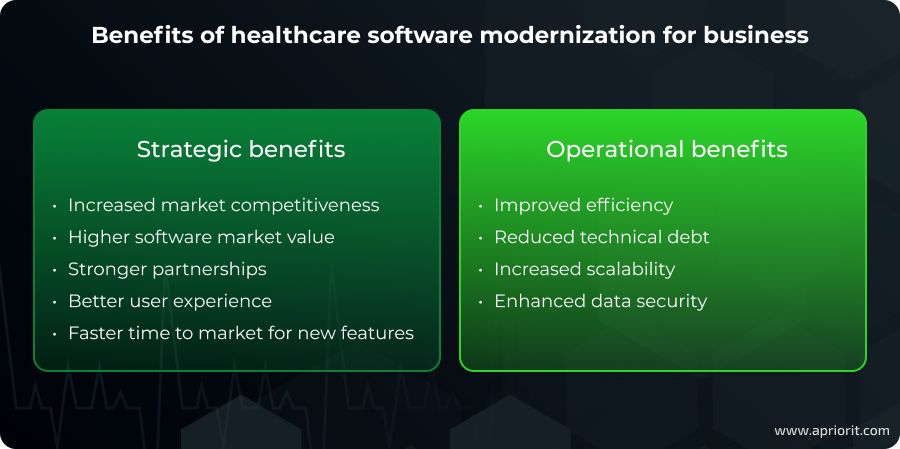
To learn more about the benefits of modernizing your software, check out our business guide to legacy software modernization. Our experts share what a legacy system is in healthcare, what you can expect from updating your legacy system, as well as tips and tricks on how to maximize benefits.
By customizing the software modernization process, you can achieve your business goals efficiently without overhauling the entire system at once. However, deciding whether to upgrade your existing software or replace it entirely is a critical step, and this choice will depend on your system’s current state and your long-term objectives. Let’s see what might be the right path for you.
Upgrade or replace: what to choose?
The decision to upgrade or replace your legacy healthcare software depends on several factors, including the severity of technical debt, the extent of required changes, and your organization’s long-term strategic goals. Not all systems can be improved with the help of modernization. Consider replacing your software if your system:
- Is outdated and cannot implement the modern technologies that you need
- Is too costly to maintain
- Cannot integrate with modern tools
- Cannot ensure data security
- Requires a complete rebuild to comply with regulations
- Needs to offer greater scalability and improved user experiences to support growth
Ultimately, the decision to upgrade or replace your legacy healthcare software should be based on a careful evaluation of your organization’s specific needs and priorities. Consulting with experienced software modernization experts can help you make an informed decision, avoid costly mistakes, and ensure a smooth transition. Let’s explore key approaches to healthcare software modernization.
Key approaches to healthcare software modernization
Choosing the right approach for modernizing healthcare software depends on your system’s current state, your business goals, and your technical requirements for the modernized solution. Here are some common modernization strategies and their ideal use cases:
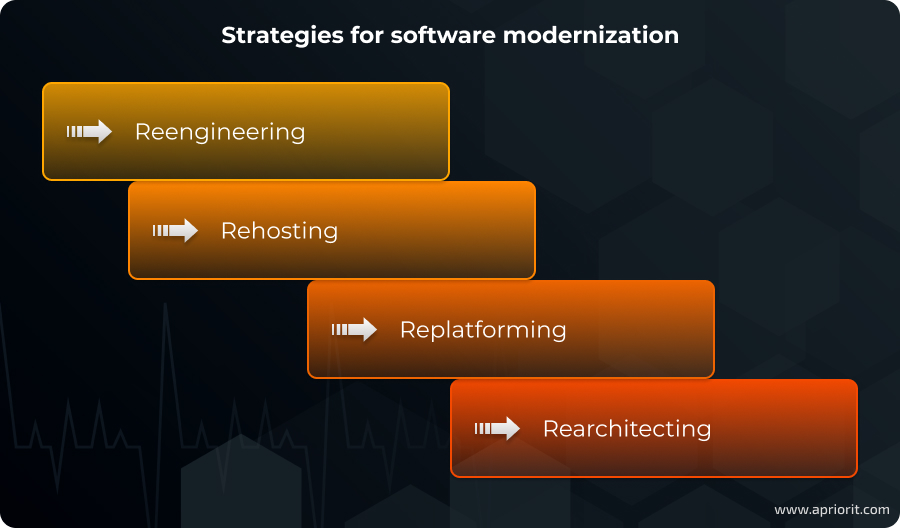
Let’s take a look at each of these strategies in detail.
Reengineering. This approach involves redesigning or redeveloping significant parts of the application to improve performance, scalability, and maintainability. It will help you focus on reworking outdated components while retaining the software’s core functionality. Some healthcare-specific examples of reengineering include:
- Updating legacy EHR systems for more robust patient data management and analysis capabilities
- Improving medical imaging applications to enable faster image processing and integration with AI diagnostic tools
- Enhancing telemedicine platforms to provide seamless video consultations and better user interfaces for physicians and patients
Reengineering is best for:
- Systems with valuable but outdated features that require extensive updates
- Businesses looking to adopt modern technologies while preserving critical functionalities
Rehosting. Also known as lift and shift, this method moves the software to a new hosting environment — for example, from on-premises servers to the cloud — without changing its core features. It helps to reduce infrastructure costs and improve software availability. In the healthcare industry, use cases for rehosting can include:
- Migrating patient management systems to the cloud to ensure remote access for healthcare professionals
- Moving clinical research databases to a cloud-based environment for better data sharing among research teams
Rehosting is best for:
- Organizations seeking a quick transition to the cloud with minimal disruptions
- Systems with stable functionality that don’t require significant changes
Replatforming. This approach is similar to rehosting but involves making various adjustments to optimize the application for the new platform. Your team can boost performance and leverage some features of the new environment, such as cloud-native services. Healthcare-specific examples of replatforming include:
- Optimizing hospital scheduling tools to use cloud-native analytics for predictive scheduling
- Enhancing pharmacy management systems to improve prescription tracking and integration with external services like drug databases
Replatforming is best for:
- Applications that need moderate updates to run efficiently on modern platforms
- Companies looking for ways to improve software scalability and performance without extensive redevelopment
Rearchitecting. This method includes redesigning the application’s architecture to make it more flexible, scalable, and suitable for modern environments like microservices or serverless computing. It often involves breaking down monolithic applications into modular components. Here is how you can apply this approach in healthcare:
- Breaking down comprehensive hospital management systems into modular microservices for billing, patient records, and resource allocation
- Designing a new architecture for a telemedicine platform based on serverless functions to handle the dynamic and unpredictable nature of patient interactions
Rearchitecting is best for:
- Systems with fundamental architectural limitations that hinder scalability and integration
While all of these methods have value on their own, organizations often choose a hybrid approach, which combines multiple strategies to address different aspects of a legacy system. This way, your organization can gain flexibility and apply tailored techniques like rehosting certain components, reengineering others, and rearchitecting critical modules.
A hybrid method is suitable for complex systems with diverse modernization requirements or for organizations looking for a balanced strategy to minimize risks and costs and deliver maximum value.
Modernization isn’t just essential — it’s an opportunity to improve and stay competitive. To make the most of this opportunity, it’s important to choose the right approach that aligns with your organization’s unique needs and goals. Let’s see what the most common risks are in the modernization process.
Read also
How Outsourcing Software Engineering Services Impacts Product Delivery
Explore the key challenges, benefits, and strategies for overcoming obstacles, all while improving efficiency and reducing the time to market. Our experts will help you understand how outsourcing can help streamline your development efforts and drive growth.
Common challenges of modernizing healthcare software
Modernizing healthcare software comes with unique challenges due to strict industry requirements and the complexity of legacy systems. Here are some challenges you might encounter that demand specific attention from your development team:
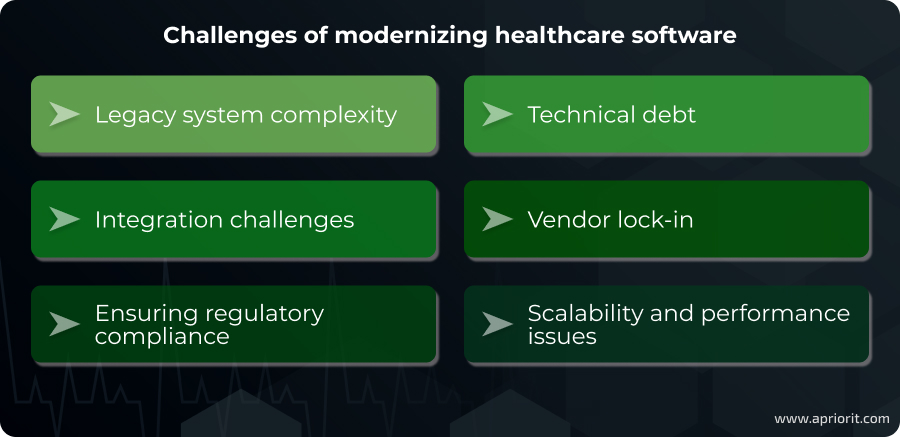
Legacy system complexity. Legacy healthcare software often relies on outdated architectures and technologies, making it difficult to modify or upgrade. These systems might include monolithic designs, unsupported frameworks, or hardware-dependent components that limit flexibility. To address this, your teams need deep expertise in both legacy and modern technologies to map the system, identify dependencies, and plan updates carefully. With the help of static code analysis and system mapping tools, you can identify technical issues within legacy codebases and visualize system architectures for better understanding.
Technical debt. Legacy software often accumulates technical debt because of poor code quality, lack of documentation, and rigid outdated designs. These issues slow down modernization efforts as your teams must invest significant time in refactoring, reverse engineering, or rewriting portions of the code. Consider using refactoring tools to improve code quality and using documentation generators to create technical documentation for existing codebases.
Integration challenges. Varying protocols, data formats, and communication standards can make it difficult to ensure compatibility between modernized software and legacy components. Your teams might consider using API management platforms for seamless integration, data transformation tools to convert legacy data formats into modern standards, and interoperability standards like HL7 and FHIR to provide frameworks for integrating healthcare systems, including EHRs, imaging systems, and other medical tools.
Vendor lock-in. Proprietary technologies and vendor-specific solutions can restrict organizations from making changes or migrating systems. Your teams can break free from vendor lock-in, which requires a detailed analysis of dependencies and migration pathways. Also, when outsourcing software modernization, organizations may become reliant on a specific vendor’s expertise or tools. Choosing an outsourcing partner that emphasizes open standards and knowledge transfer can mitigate this risk for your organization.
Ensuring regulatory compliance. Modern systems need to comply with the requirements of HIPAA, the GDPR, the FDA, and other laws, regulations, and agencies. It can be difficult to incorporate new technologies like AI and remain compliant since the process needs algorithm transparency and data handling practices. Additionally, transitioning to modern systems can reveal security vulnerabilities, increasing the risk of data breaches and unauthorized access and potentially compromising sensitive patient information. Your team needs to have a deep understanding of medical software to address these challenges and reach a balanced approach to innovation and compliance.
Scalability and performance issues. Legacy systems may struggle to handle increasing data volumes, complex workloads, and real-time processing demands. It might be challenging for your team to make sure that the system can scale efficiently and maintain high performance. Cloud platforms like AWS, Azure, and Google Cloud provide scalable infrastructure and services for handling large workloads. You can also simulate workloads and validate performance under stress with the help of load-testing tools like JMeter.
By tackling these issues early, you can transition smoothly to modern software that increases operational efficiency and ensures long-term compliance. In the next section, we share how you can streamline the modernization process, mitigate risks, and maximize the long-term value of your investment.
Read also
Adopting Generative AI in Healthcare: Key Benefits, Use Cases, and Challenges
Learn how AI is transforming healthcare processes, improving patient care, and enhancing operational efficiency. From personalized treatment plans to automation in administrative tasks, we cover how generative AI can streamline workflows and make a meaningful impact on the industry.

Apriorit’s best practices for modernizing healthcare software
When upgrading your old software, your developers can be overwhelmed by the potential volume of different processes and operations. At Apriorit, our experts have created a list of tips and best practices based on years of experience modernizing complex healthcare systems:
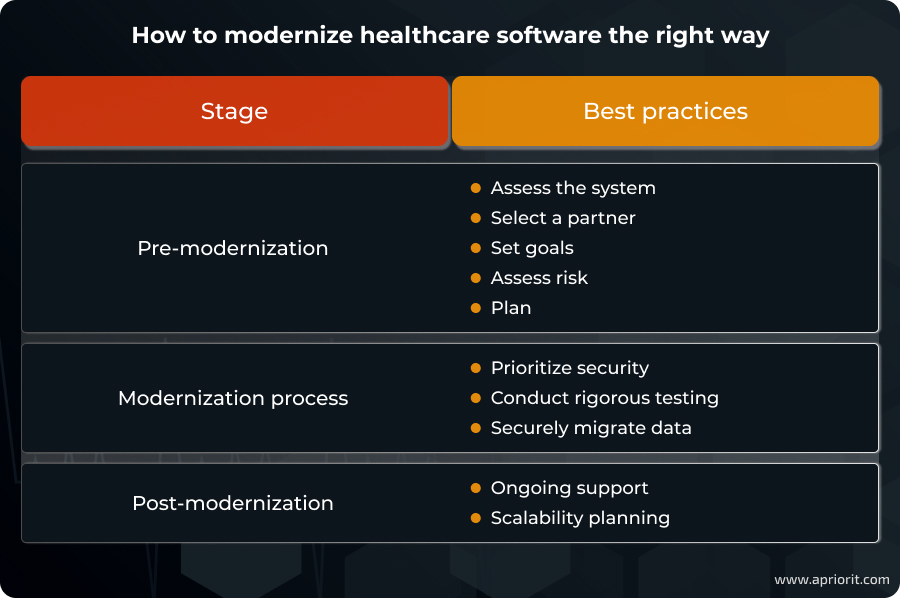
Let’s look at each of these practices in detail.
Pre-modernization
Before starting a healthcare software modernization project, it’s important to build a strong foundation. This involves analyzing your current system and setting clear goals to address challenges and guide the modernization process. Here is what your team should do during this stage:
- Thoroughly analyze the system. You need to evaluate the current system’s strengths, limitations, and risks. For example, your teams can start by identifying outdated features, inefficiencies, and security vulnerabilities. By mapping out areas that need improvement, you can better understand how the system functions and where modernization efforts will have the most significant impact. Tools like system profilers and performance analyzers can help pinpoint bottlenecks and performance gaps.
- Decide on your development approach. Your choice of outsourcing partner can make or break your software modernization project. Look for experts with a proven track record in healthcare IT who understand both compliance requirements and technical complexities. For example, you can evaluate potential partners based on their portfolios, case studies, and client references. A reliable partner will bring industry insights and technical expertise, reducing risks and ensuring the smooth implementation of your development plan.
- Define modernization goals and priorities. Once the analysis is complete, you can move on to setting clear objectives for the modernization project. These should align with organizational priorities, such as improving operational efficiency or integrating with EHR, EMR, PACS, and other healthcare systems. This can help your team make sure that the project stays focused and delivers measurable benefits. Collaborating with stakeholders during this stage can guarantee that the end goals meet the organization’s clinical, operational, and business needs.
- Assess risk and develop a mitigation plan. Software modernization involves potential risks, including data breaches, system downtime, and non-compliance with healthcare regulations. It’s important to identify these risks early and develop a comprehensive mitigation plan. You can include contingency strategies for various challenges, such as data recovery protocols and backup systems. Using risk management software or consulting with cybersecurity experts can also help you design effective risk mitigation strategies.
- Develop a solid modernization plan. A detailed plan can help you manage resources, minimize disruptions during modernization, and stay on schedule. This plan can include project objectives, timelines, and a change management strategy to address potential resistance or challenges during the transition. You might also want to outline how the team will maintain the continuity of the software’s operations during the process so there are no disruptions.
These practices can help you anticipate challenges before modernization starts and create a solid roadmap for success.
Modernization process
As this stage focuses on executing the modernization project, you need to adopt a structured approach to make sure that the transformation is secure, efficient, and aligned with healthcare-specific requirements. Here are some strategies to help you achieve this goal:
- Migrate data securely. Migrating sensitive data, such as patient records, must be done carefully to prevent breaches or data loss. Your teams need to use secure data transfer protocols (TLS, SFTP, HTTPS), robust storage mechanisms (data masking, backup systems, access controls), and encryption tools (AES, PGP) during migration. This can help you make sure that all critical information is accurately transferred to the new system.
- Ensure security and compliance. Compliance with regulations such as HIPAA, HITECH, and the GDPR is non-negotiable in healthcare IT. You should implement various security measures to protect sensitive patient data, such as data encryption, multi-factor authentication, and access controls. You should also conduct regular security audits throughout the process, whether with the help of your in-house team or outside specialists.
- Test rigorously with a focus on healthcare workflows. This practice can help ensure that the modernized system supports clinical workflows and improves care delivery in the long run. Conduct usability tests with medical staff and end-users to identify pain points or areas needing adjustment. Automated testing tools and simulation environments can help validate performance under real-world conditions. This way, you can make sure your modernized system meets healthcare-specific demands such as quick access to patient data, seamless integration with EHR systems, and reliable uptime for critical operations.
With the help of these practices, you can transform outdated systems into secure and efficient solutions that meet modern healthcare demands.
Post-modernization
Modernization doesn’t end with software implementation. Ongoing support and scalability planning help your modernized system continue to deliver value and remain relevant in a quickly evolving healthcare landscape. Here is what you can do to achieve these goals:
- Establish post-modernization support. This support can include regular updates, patches, and performance monitoring for ongoing system maintenance. Your teams should be able to address any issues and user requests promptly and remain compliant with changing regulatory requirements.
- Plan for scalability and future-proofing. Your modernized system should be flexible enough to integrate emerging technologies such as AI-driven analytics, telemedicine platforms, IoT, or personalized healthcare tools. Your teams can conduct periodic assessments to check how the system adapts to organizational needs and technological advancements. Scalable architectures, such as microservices or cloud-based platforms, can also help to future-proof your solution.
With the right strategy and industry expertise, you can transform your systems smoothly and improve operations for long-term success.
Related project
Supporting and Improving Legacy Data Management Software
Discover how Apriorit’s expertise in legacy system optimization helped our client enhance performance, reduce operational costs, and drive business growth.
How can Apriorit help with your modernization project?
With Apriorit as your partner, you can adopt a comprehensive approach to tackle any issues efficiently and confidently. Our team of professional engineers and security experts has decades of experience that you can leverage to achieve your software modernization goals.
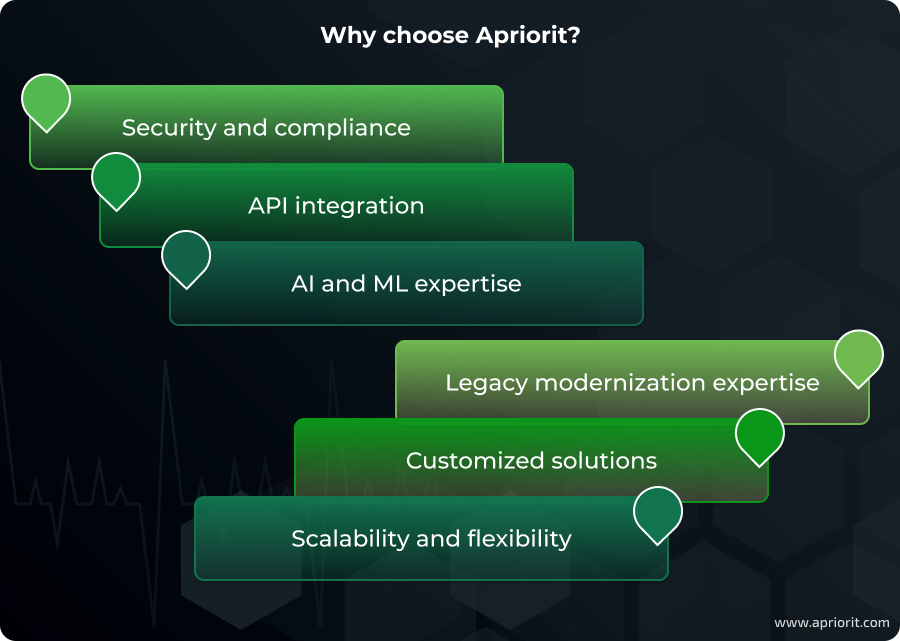
- Security and compliance. With Apriorit, you will gain peace of mind knowing your software meets strict healthcare requirements. Our efficient security measures protect sensitive patient data and minimize legal risks.
- API integration. Apriorit’s expertise in seamless API integration helps you connect EHR, EMR, PACS, and other systems, building efficient data pipelines and reducing data silos. API integrations can also enhance the interoperability of your systems and streamline workflows in the long run.
- AI and ML expertise. Leverage our AI and machine learning capabilities to create solutions for predictive analytics, intelligent diagnostics, and personalized healthcare. Apriorit experts can help you stay ahead of industry trends and remain competitive.
- Legacy modernization expertise. Transition smoothly from outdated systems with Apriorit’s deep knowledge of legacy modernization. We guarantee minimal disruption, preserve critical functionalities, and position your software for future growth.
- Customized solutions. Our tailored modernization strategies align perfectly with your unique needs, helping you achieve specific business goals. With our expertise, you can be sure that your upgraded software addresses operational challenges and maximizes efficiency.
- Scalability and flexibility. Apriorit designs systems that grow with your organization, allowing you to handle increasing workloads and adopt emerging technologies. This future-proof approach guarantees that your investment delivers long-term value.
Whether it’s enhancing security, building new projects from scratch, or overcoming integration issues, our team is committed to delivering solutions that transform your healthcare software into a robust and future-ready system.
Conclusion
Modernizing healthcare software is a complex and demanding process, often involving challenges such as data migration, regulatory compliance, and technology integration. If not addressed properly, these issues can lead to delays, increased costs, and operational inefficiencies. Without the right expertise, the modernization journey can quickly become overwhelming.
To successfully modernize your healthcare software and overcome these challenges, you need a trusted partner with the experience and expertise to navigate these complexities. With Apriorit’s proven track record in healthcare software development, we can guide you through every step of the process, from planning and execution to ongoing support.
Reimagine your healthcare software by hiring the right tech vendor
Trust Apriorit to help you in your project modernization journey, ensuring success at every step.


